Glenna Goodacre
US Coin Designer and Engraver - Sacagawea Dollar
Glenna Maxey Goodacre was born in 1939 in the town of Lubbock, Texas. Her father, Homer Glen Maxey, worked in Lubbock as a prominent developer, builder and civil leader. Glenna grew up in Lubbock with an interest in art, painting and sculpting before graduating from Monterey High School. Early in her career, she attended Colorado College and further studied the arts at the Art Students League located in New York. Early on, Goodacre worked as a successful painter, but she later settled into sculpting in 1969 at the age of 30. Over the next few decades, she became highly skilled and experienced in her work. Throughout that time, she also took care of her family as a mother, grandmother and wife. She is also mother of the famous 1980s supermodel Jill Goodacre.
In 1983, Glenna and her husband, attorney C.L. Mike Schmidt, moved further west to New Mexico where they lived in Santa Fe and Pecos since. About 10 years later in 1993, Glenna sculpted one of her most famous works called the "Vietnam Women's Memorial". This monument was unveiled November 11, 1993 on Veteran's Day, and it now stands at the National Mall located in Washington DC. The bronze sculpture was created to honor the 11,000 women who served in the Vietnam War. This popular work of art helped propel her name and reputation as a highly skilled artist.
Only a few years later in 1997, Glenna Goodacre was chosen out of 100+ artists from around the world to be the sculptor who would work on the Irish Famine Memorial, which would be located in Philadelphia. This massive bronze monument depicts 35 life-sized figures and honors the 150th anniversary of the Great Hunger in Ireland. This dynamic artwork moves like a story. The display begins with the people of Ireland in the misery and darkness of famine and death. The depiction progresses to show them walking onto a ship, immigrating to the United States and walking off the ship to a new life of hope and prosperity. The sculpture was finished in 2003 and was installed at Penn's Landing where it would overlook the Delaware River, where many of the same Irish people first step foot in America.
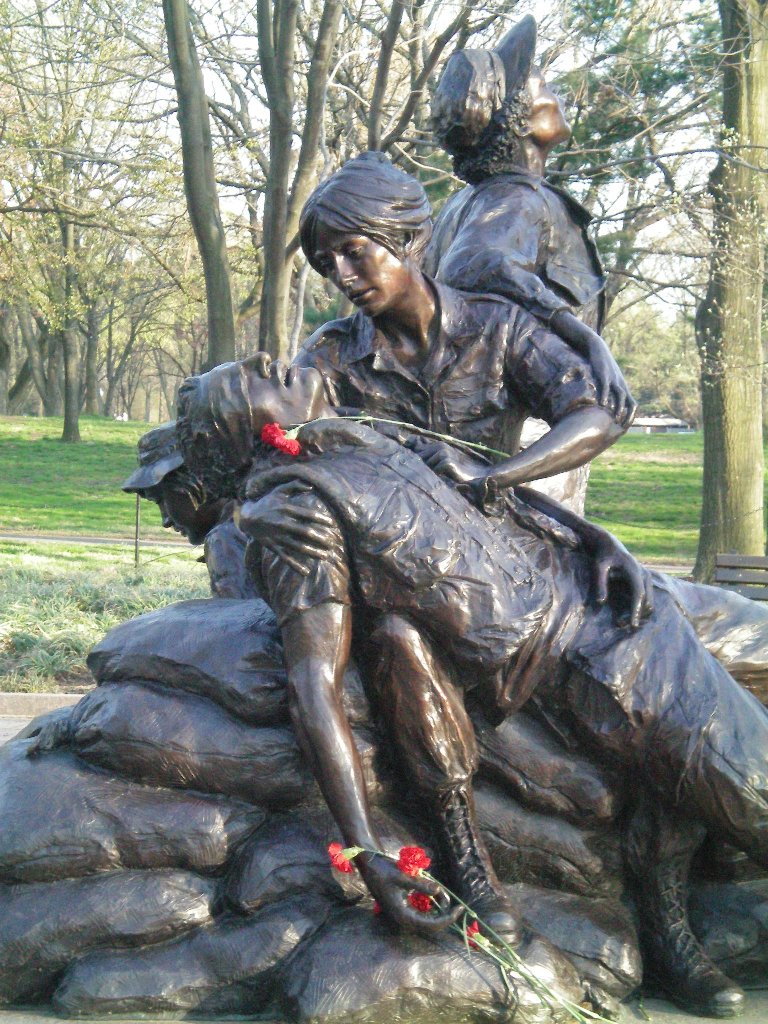
A photo of the bronze Vietnam Women's Veteran Memorial, sculpted by Glenna Goodacre.
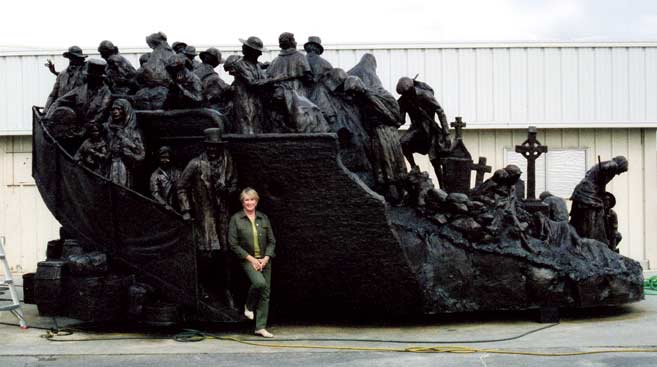
A photo of the bronze Irish Famine Memorial, sculpted by Glenna Goodacre.
In 1998, Goodacre completed an 8 foot tall work depicting US President Ronald Reagan, which was revealed at the Ronald Reagan Presidential Library in California. Throughout her career, she also made life-sized statues for General (future President) Dwight Eisenhower, Greer Garson, Scott Joplin and Katherine Porter. In fact, she created more than 500 amazing pieces of art that can be seen in more than half of the states located in the US!
The following year in 1999, Goodacre entered a nationwide competition to design a proposed Sacagawea US dollar. On December 1, 1997, President Bill Clinton signed the 50 States Commemorative Coin Program Act, which also contained the United States $1 Coin Act of 1997. This authorized the production of a new golden colored one dollar coin, which would have a distinct edge and would have visible features to make it much easier to distinguish from other US coins. The Susan B. Anthony Dollar failed because it was too similar to the US Quarter. This new coin was also going to be small, so the US Mint hoped that it would be more successful than it's predecessor.
Invitations were sent out to 23 prominent artists and sculptors to design the new coin. The requirements stated that the obverse must depict Sacagawea and the reverse must depict an eagle to represent freedom and peace. Glenna Goodacre used Randy'L He-dow Teton as the model for the bust of Sacagawea. Randy'L He-dow Teton attended the nearby University of New Mexico and is also part of the American Indian Shoshone tribe just as Sacagawea was. The obverse of the new coin depicts Sacagawea carrying her baby Jean Baptiste Charbonnea. The reverse of the coin featuring the eagle, was designed by Thomas D. Rogers. Sacagawea is extremely important to the history of the United States because she was the guide during the Lewis and Clark expedition of 1804-1806. Without her help and guidance, Lewis and Clark may not have survived, nor been successful in their expedition to the Pacific Ocean and exploration of the uncharted territories and lands of Western America.
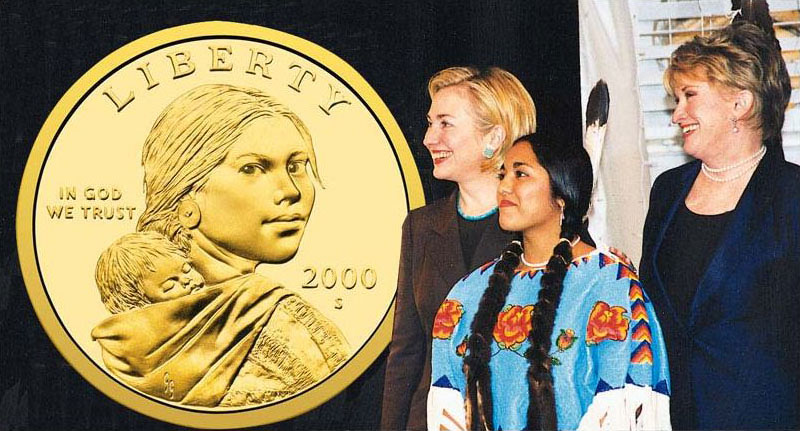
The design of the Sacagawea Dollar unveiled at the White House. Left to Right: First Lady Hillary Clinton, Sacagawea Model Randy'L He-dow Teton, Designer Glenna Goodacre.
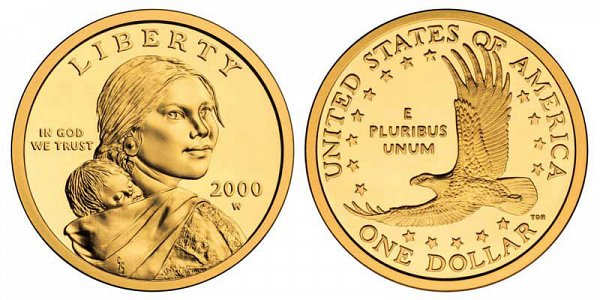
Design of the Sacagawea Dollar. Obverse designed by Glenna Goodacre, Reverse designed by Thomas D. Rogers.
This new coin was first officially struck on November 18, 1999 during a ceremony where dignitaries and special guests were allowed to strike coins one at a time.. Although the coins were not legally allowed to be released until 2000, in which the dignitaries and Glenna Goodacre received the coins they struck. Throughout that first year, over a billion of these coins were produced at the US Mints. The dollar coins themselves were golden in color, but do not actually contain any real gold metal. Instead, they contain 88.5% copper, 6.0% zinc, 3.5% manganese and 2% nickel. This overall manganese bronze composition is what gives the coin it's golden appearance.
These coins were struck every year since 2000 up until the present date. On September 20, 2007, US President George W. Bush signed the Native American $1 Coin Act. This new coin act required that a new reverse be designed each year, celebrating important contributions by Native Americans and Indian Tribes towards the development of the United States and it's history. The new Native American & Sacagawea Dollar series would still depict Glenna Goodacre's Sacagawea design on the obverse, but the date would be removed and our motto "E PLURIBUS UNUM" would be removed from the reverse. Instead, the motto and the date would be minted on the edge of the coin. The new Native American series would begin in 2009 and last until 2016.
After producing the Sacagawea dollar, Goodacre continued working on sculptures and artwork. Notable works of art included a 2004 bronze portrait depicting West Point Coach Colonel Earl "red" Blaik and the design of the Children's Medal of Honor Award, awarded to First Lady Laura Bush. Goodacre won all kinds of awards and honors during her career. In 1997, she was inducted to the West Texas Walk of Fame in her hometown. Goodacre's alma mater Colorado College gave her an honorary doctorates degree, as did Texas Tech University, located in her hometown of Lubbock. In 2002 at the Prix De West Exhibition, she received the James Earle Fraser Award for sculpture. On an interesting side note, the name of this award is named after James Earle Fraser, another great US coin designer responsible for the design of the Buffalo Nickel (also known as the Indian Head Nickel) and many other Western American and Native American works of art and sculpture!
In 2003, Glenna Goodacre was inducted into Fort Worth's Cowgirl Hall of Fame and was awarded the Texas Medal of the Arts. In 2005 in her hometown of Lubbock, Texas, 8th Avenue was renamed to "Glenna Goodacre Boulevard" in her honor. Also at the Santa Fe State Capitol, New Mexico Governor Bill Richardson awarded Goodacre the Award for Excellence in the Arts. Her involvement in US coins did not end with the Sacagawea dollar. In fact, the Governor appointed her to the State Quarter Design Committee, which was involved in the feedback and design of the New Mexico Quarter to be used in the 50 State Quarter Program.
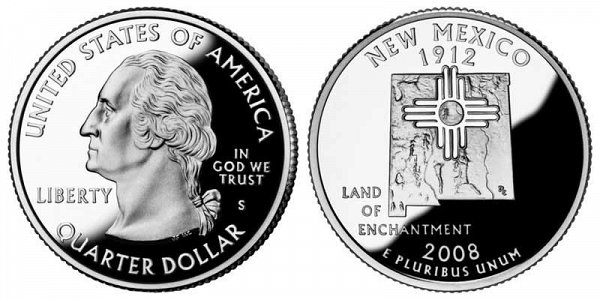
Design of the 2008 New Mexico Quarter, designed by Don Everhart. Glenna Goodacre served on the State Quarter Design Committee for this New Mexico Quarter.
Unfortunately in March, 2007, Glenna Goodacre had a serious fall and suffered a severe head injury before going into a coma on March 13, 2007. Her husband reported that he didn't know if she fainted, or if she possibly had a mini-stroke, which may have resulted in her fall. Fortunately, her husband reported on April 9, 2007 that Glenna had made excellent progress, was no longer bedridden and could stand again. A few months later in August of 2007, it was reported that she was able to return home and could continue her normal activities with her family. After returning home, she returned to her studio each day near her home. On January 18, 2008, her was in good enough health to be able to unveil one of her new sculptures, called "Crossing the Prairie", at St. Vincent Regional Medical Center. That same year, she was named "Notable New Mexican" by the Albuquerque Art and History Museum Foundation and a portrait of her, designed by artist Daniel Greene, is included as part of the permanent collection at the Museum.
The year 2009 marked her 40th anniversary as a sculptor, and many of her sculptures were exhibited and a 240 page book about her and her art was published. The next year in 2010, she received the Christopher and Dana Reeve Inspiration Award, given to her by the Craig Hospital Foundation located in Denver, Colorado. Also in 2010, her designs for the Sacagawea dollar were included in the Smithsonian Numismatic Collection in Washington DC, in honor of the 10th anniversary of the Sacagawea Dollar. Then in 2013, she was awarded the Lifetime Achievement Award, given to her by the Booth Western Art Museum of Cartersville, Georgia.
Glenna Goodacre produced more than 500 major works of art and won countless awards. She is considered by many American folks as "America's Sculptor". Her works are on display in many public, private, municipal and museum collections across more than 40 countries. Many of her works aim at "capturing the essence of humanity that reaches out, touches us and draws us to it". She states that "people can walk up and touch it... They want to look in the eyes and want to think about it or smile". Goodacre later says she always prefers realistic, academic and classical approaches when sculpting, focusing on the figure and head. With each experience, she becomes better at representing the emotions with body language and facial expressions within the sculpture, becoming less involved with details and more conscious of the composition, texture and design.
Early on her career at the age of nineteen, she noted that her college sculpture professor advised her that she should never attempt to make a sculpture, and convinced her to do just that for around 10 years. The professor stated that Goodacre was unable to see three dimensional form and promptly gave her unsatisfactory grades for her effort. She stated in retrospect, it gave her more time to learn and master the basic of figure proportions, anatomy and drawing. Goodacre later said that she was looking forward to the next 25 years, that she could not imagine herself retiring, but would continue making more sculptures, taking her time working on each piece, gaining more wisdom and knowledge. She'll always enjoy working with different ethnic types and with children, using them as models for her sculptures.
Coin designer and sculptor Glenna Goodacre also has her own personal and business website: http://www.glennagoodacre.com/
